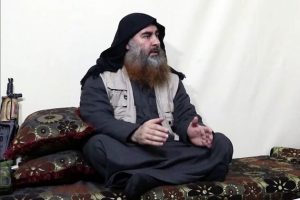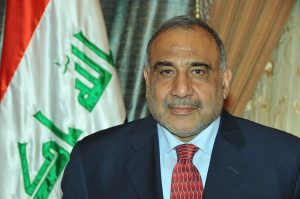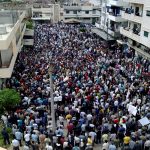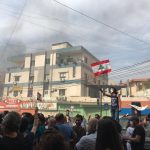by Richard Sindelar
The Islamic State hasn’t been defeated. The most horrendous of terror organizations is not going anywhere, not for quite a while.
The much-trumpeted fall of the Islamic State’s last town, Baghuz, in Syria is irrelevant in terms of U.S. security and policy. For all intents and purposes, the territorially-based central caliphate ended with the fall of Raqqa, the putative capital in October 2017, not the recent mopping-up operations in a small provincial way-stop.
If anything, the Islamic State (ISIS or IS) will now enter into its most dangerous and virulent phase. Computer documents captured from IS’s last fleeing remnants indicate that IS leadership has already called upon its dispersed legions, and Internet-inspired adherents, to “organize, arm, and fund” new terror operations in vengeance for the fall of the caliphate.
After Raqqah, IS continued its process of metastasizing into version 3.0, which will infect principally the Middle East and the West, but also break out unexpectedly in any corner of the globe.
The Stages of Terror
Each modern Middle East terror movement has proceeded through usually four main stages, before eventually being largely extinguished. First comes early gestation, in which Western intelligence agencies have only vague notions of the group. Then comes breakout, usually with some media-grabbing spectacle. This is followed by persistent virulence, marked by significant attacks over a number of years. Finally comes the fadeaway.
The lifespan of these groups is not brief. Each typically lasts 30-50 years, driven as much as anything by generational change. Sons and daughters rarely pursue either the same agendas or ideologies of their fathers with the same level of commitment. Instead, they focus on and adjust to the different issues and forces of their own era. Hence the phase four fadeaway.
Fatah, gestated from the frustrations, discontent, and militancy of dispossessed Palestinians, began as a small group of ragtag guerrillas based in Jordan, with the announced goal of pushing all Israelis into the sea. This embryonic stage grew slowly until the March 21, 1968 Battle of Karameh, the breakout, where a resounding military defeat by IDF forces nevertheless was spun into a legendary tale of resistance.
Fatah, the largest faction of the Palestinian Liberation Organization (PLO), grew. The 1972 Munich massacre became its high-water mark, catapulted Middle East terror into the international consciousness, and launched Fatah into its third most virulent stage—an era of numerous terror operations that captured headlines. This third very public stage is usually the most virulent.
But Yasser Arafat and the PLO overplayed their hand. Their hubris prompted their involvement in Lebanon’s civil war, which drained their energy, commitment, and coffers. By the 1980s, many of the original leaders had been killed, and the PLO began a slow slide from a feared terror agency into a weakened and splintered remnant of its former self, mounting fewer and fewer attacks. Eventually, the PLO devolved into a weak political force, eschewing terror by the mid-1990s. In 30 years, the PLO had grown from a small group into a force, then aged and spent itself.
Al-Qaeda followed a similar path. Coming out of the Afghan resistance to Soviet occupation, al-Qaeda also adopted the banner of resistance, but to the Saudi regime and to Western influence and power in the Middle East. In the early 1990s, outside observers knew of its existence but considered it an odd little group with a vague manifesto.
The February 1993 bombing of the World Trade Center was al-Qaeda’s breakout. Morphing into stage three virulence, it conducted the simultaneous bombing of two embassies in Africa, followed by its signature 9/11 attack. It mounted numerous suicide bombings and other terror attacks with different methods (shoes, liquids, powder).
After the U.S. invasion of Afghanistan, al-Qaeda lost its territorial base and entered phase four. It fractured into smaller groups in disparate regions, with dwindling financial backing from its supporters in Saudi Arabia and elsewhere. Now, 25-30 years after it began, al-Qaeda cannot be discounted entirely. But it is less of an overall threat in the Middle East and North Africa region.
The Evolution of IS
Like al-Qaeda, the Islamic State was born out of resistance in a civil war, this time Sunni frustrations in western Iraq and dispossession from power after the March 2003 Iraq invasion. IS started out as a branch of al-Qaeda in Iraq. It was on the radar of intelligence agencies, which, however, underestimated its potency. Its phase-two breakout was the startling run from Syria to the outskirts of Baghdad, and its attempt to recreate the early Islamic Caliphate.
With the fall of Raqqa, IS entered its third and most dangerous phase. When it held extensive territory, intelligence agencies could more easily pinpoint and counter the group. Its political leadership, the bulk of of its military might, and its economic base were all based in the caliphate. Having been pushed out of its territory, IS has gone to ground across the Middle East, North Africa, and other locales. It has become much more difficult to track, to gather intelligence on, and strike back against.
And IS still retains considerable resources. It commands 10,000-30,000 fighters, from insurgent cells still underground in Iraq and Syria to “provincial” groups in Sinai, Libya, and Yemen. A widely circulated National Counterterrorism Center “heat map” shows 18 countries with IS operations. Al-Qaeda struck the World Trade Center the second time with just 20 terrorists. If even a small number of current IS fighters plan and carry out terror operations similar to 9/11 and the Paris Bataclan incident, the toll could be enormous.
Perhaps even more virulent may be followers on social media inspired to action by IS ideology. Undeclared foreign IS fighters melting quietly back into their home countries become potential sleeper cells for later action. Meanwhile, funding continues to flow from criminal activity or longstanding Saudi and other financial backers motivated either by shared ideological beliefs or the persistent paranoia about countering Shia Iran.
After the fall of Baghuz, IS presents a clearer and more present danger to the interests of the United States and its allies as a series of potential transnational terror attacks in multiple places. Such attacks, like the ones that have already taken place in Paris and Brussels, may persist for another 10 or even 20 more years. Nor will the U.S. homeland be immune. Indeed, no longer focused on trying to hold territory, IS in this third phase will look elsewhere to strike, and the hated U.S enemy’s territory will become a prime target.
Richard Sindelar, a retired U.S. diplomat with three tours of duty in the State Department’s Bureau of Intelligence and Research, now serves as assistant professor of international studies at Houston’s University of St. Thomas, where he teaches courses in U.S. foreign policy and international security, among others.






A chilling report
Typical establishment figure pompously bloviating with the sole intent of creating an enemy for future military sales adventures.